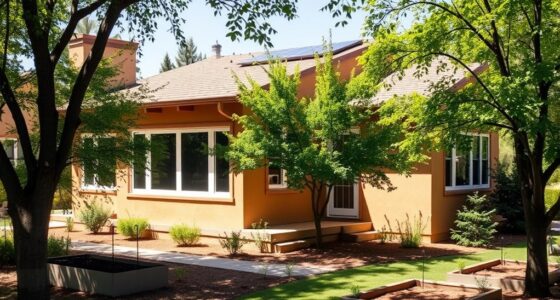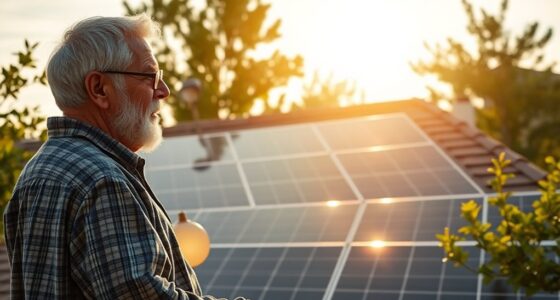Upgrading your windows for energy efficiency involves choosing the right materials, like vinyl, fiberglass, or properly insulated aluminum, to prevent heat transfer. Sealing gaps with weatherstripping and caulk, adding insulating foam around the frame, and opting for double or triple-glazed windows with inert gas fills can also make a big difference. Proper installation guarantees a snug fit and limits drafts, boosting your home’s comfort and saving you money. Keep going to discover how to maximize these upgrades effectively.
Key Takeaways
- Choose energy-efficient window frame materials like vinyl, fiberglass, or properly insulated wood for better insulation.
- Install double or triple-glazed windows with inert gas fills to reduce heat transfer.
- Use sealing techniques such as weatherstripping and caulk to prevent drafts and air leaks.
- Ensure proper window installation to achieve a snug fit and optimal sealing for maximum efficiency.
- Combine high-quality materials with effective insulation and sealing practices to enhance overall energy savings.

Upgrading your windows is one of the most effective ways to improve your home’s energy efficiency. When you choose new windows, paying attention to the window frame materials can make a significant difference. Different materials offer various levels of insulation and durability. For example, vinyl frames are popular because they’re affordable, require little maintenance, and provide good insulation. Wood frames, on the other hand, offer excellent insulation but need regular upkeep to prevent rot. Aluminum frames are sturdy but tend to conduct heat and cold more easily, making them less energy-efficient unless they have a thermal break. You might also consider composite or fiberglass frames, which combine durability with impressive insulating properties. Selecting the right frame material tailored to your climate and budget can help reduce heat transfer and keep your home comfortable year-round.
Choosing the right window frame material enhances insulation and durability for year-round comfort.
In addition to choosing the right window frame materials, mastering insulation techniques is essential for maximizing energy savings. Proper insulation around your window frames prevents drafts and heat loss. Modern installation methods often include expanding foam or rigid foam boards around the perimeter of the window frame before sealing it with weatherstripping or caulk. These techniques create a tighter seal, reducing air leaks and enhancing energy efficiency. When you install new windows, make sure they come with high-quality weatherstripping to further prevent drafts. Double or triple-glazed windows, featuring inert gas fills like argon or krypton, also considerably improve insulation by minimizing heat transfer through the glass. Combining these insulation techniques with well-chosen frame materials will result in a more energy-efficient window system.
Furthermore, understanding how to properly install your windows is essential for reaping their full benefits. Even the best materials won’t perform ideally if installed incorrectly. Ensuring a snug fit and proper sealing around the window frame prevents air leaks and moisture intrusion. If you’re considering DIY installation, educate yourself on best practices, or better yet, hire a professional to guarantee that insulation techniques are correctly applied. Proper installation and attention to detail can reduce your heating and cooling costs substantially over time. Additionally, incorporating an awareness of creative practice can foster innovative solutions during installation or renovation projects, leading to more effective energy-saving strategies.
Ultimately, upgrading your windows isn’t just about aesthetics; it’s an investment in your comfort and savings. By carefully selecting window frame materials suited to your climate and applying effective insulation techniques, you create a barrier against energy loss. This not only lowers your utility bills but also makes your home more environmentally friendly. The key lies in combining quality materials with precise installation to maximize the energy efficiency of your new windows.
Frequently Asked Questions
How Often Should I Replace My Windows for Optimal Energy Savings?
You should consider window replacement every 15 to 20 years for ideal timing. Over time, windows lose energy efficiency due to wear and tear, reducing your savings on heating and cooling costs. Keep an eye out for drafts, condensation, or difficulty opening, which signal it’s time for new windows. Regular maintenance and inspections will help you decide when it’s best to upgrade for maximum energy savings.
Do Energy-Efficient Windows Require Special Maintenance?
Think of your energy-efficient windows as the heart of your home’s comfort. They do require some tender loving care—regular window cleaning keeps them sparkling and free of dirt that can diminish their efficiency. Sealant maintenance is equally crucial; check for cracks or gaps and reseal as needed to prevent drafts. With a little upkeep, your windows will continue to protect and preserve your home’s warmth and savings.
Can Upgrading Windows Reduce My Home’s Overall Cooling Costs?
Yes, upgrading your windows can lower your home’s cooling costs. New energy-efficient windows improve insulation, reducing heat gain during summer. You might also consider window tinting, which blocks UV rays and keeps your home cooler. Better window insulation and tinting work together to maintain a comfortable indoor temperature, lessening your reliance on air conditioning, and ultimately saving you money on cooling expenses throughout the season.
Are There Government Incentives for Upgrading to Energy-Efficient Windows?
Yes, there are government incentives for upgrading to energy-efficient windows. For example, you might qualify for government rebates or tax incentives that help offset the costs. Imagine saving hundreds on your installation bill because of these programs. These incentives encourage homeowners to upgrade, making your home more comfortable and energy-efficient. Check local and federal programs, as they often have specific requirements and benefits for energy-efficient window upgrades.
How Long Does It Typically Take to See Energy Savings After Installation?
You’ll typically see energy savings within a few days to a few weeks after installation, depending on your home’s insulation and climate. The installation timeline usually takes one to two days, and the savings timeline begins right afterward. As the new windows reduce heat transfer, you’ll notice lower heating and cooling costs quickly. Keep in mind, consistent savings will grow over time as your home maintains better temperature regulation.
Conclusion
Upgrading your windows isn’t just a simple improvement—it’s your direct path to a warmer, more energy-efficient home. Think of it as planting seeds for long-term savings and comfort, where each upgrade grows into a fortress against energy loss. Don’t wait for the cold to remind you—take action now. Remember, your home’s efficiency hinges on your choices. Make the smart move today, and watch your energy bills shrink as your home becomes a haven of comfort.









